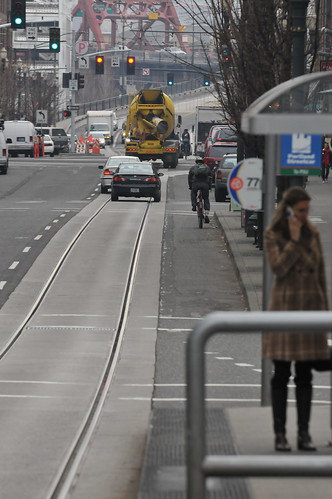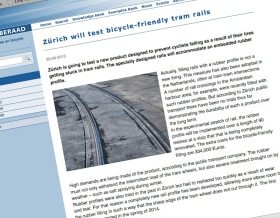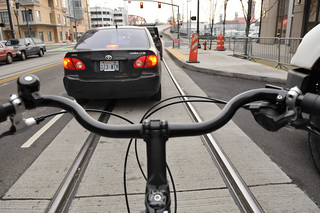While Portlanders continue to suffer physical injuries and property damage due to falls on streetcar tracks and our local agencies put out safety videos and erect signs warning about the hazards, cities in Europe are actively trying to solve the problem. In the past few weeks we’ve come across word of new technology being tested in Zurich while at the same time hearing new first-hand accounts of the treacherous cycling conditions around the (relatively) new streetcar tracks on Northwest Lovejoy Street in Portland.
“Sometimes as many as 5 times a day someone takes a bad spill by getting their bike tires caught in the streetcar tracks, I have lived here for three years, and I am amazed that no one has been run over by a car or the streetcar yet.”
— Liz B., NW Lovejoy resident
Pearl District resident James B is just one of many readers who have emailed us over the past few years to share concerns about the frequent crashes he sees near his home. “The city painted the treacherous SE corner at NW 10th Ave and Lovejoy as no parking for cars,” he wrote back in July, “However, too many cyclists still get fouled in the streetcar tracks there and get hurt — I hear the sound from my window of bikes wiping out several times daily.”
Then earlier this month he wrote us again: “Took a bag of ice down to an injured cyclist today. This intersection continues to be a menace. Do you know if Portland Streetcar and/or the city are doing anything about it?”
Also this month we heard from reader Liza B. Like James and others who have contacted us, she is disturbed and genuinely concerned by all the people who crash on the tracks on Lovejoy near 10th. As a retired senior citizen, Liza said she spends a lot of time in her apartment on Lovejoy. It faces NW 10th, so she watches the street a lot. “It is amazing to me how many spills I hear and witness out here, I would have thought that by now most regular bikers would be more cautious or take a different street.”


(in the background) because it’s direct and
— prior to the new streetcar line — it used to have a bike lane.
Liza continued: “I am so worried I am going to hear or witness a horrid accident soon… and sometimes as many as 5 times a day someone takes a bad spill by getting their bike tires caught in the streetcar tracks, I have lived here for three years, and I am amazed that no one has been run over by a car or the streetcar yet.”
Liza also added that she used to ride a bike and that she misses it, but she can’t afford to ride and she can’t afford to take a spill. “I might end up in the hospital!”
Unfortunately, despite these incessant stories from residents and the clear physical toll these tracks are taking, there doesn’t appear to be much urgency at all from the Portland Bureau of Transportation or Portland Streetcar Inc., to find a solution to the problem. As we reported last month, PBOT isn’t doing any active testing of products that might mitigate this public safety hazard and Portland Streetcar has only emailed a German company to learn more about a potential solution.
Meanwhile, we’ve learned from Dutch cycling organization Fietberaad that the city of Zurich is testing a new product, “designed to prevent cyclists falling as a result of their tires getting stuck in tram rails.”
Here’s more from Fietsberaad:

“The specially designed rails will accommodate an embedded rubber profile. Actually, filling rails with a rubber profile is not a new thing. This measure has also been adopted in the Netherlands, often at train-tram intersections. A number of rail crossings in the Amsterdam harbour area, for example, were recently fitted with such rubber profiles. But according to Zürich public transport there have been no trials thus far demonstrating the durability of such a product over the long term.
In the experimental stretch of rail, the rubber profile will be implemented over a length of 90 metres at a stop that that is being completely renovated. The extra costs for the bicycle-friendly filling are 334,000 Euros.”
We would love to report similar testing underway here in Portland. After all, we have the most developed bike and streetcar infrastructure in America so shouldn’t we be leading the charge in making sure they play nicely together?
Right now, the best way for many people to avoid the potential of a nasty crash on streetcar tracks is to avoid them and get familiar with alternate routes whenever possible. For all those riders who don’t know the best routes, and who are simply trying to navigate our city by bike, all we can say is good luck and we hope your injuries aren’t too severe.
— Read more bikes and streetcar coverage in our archives.


